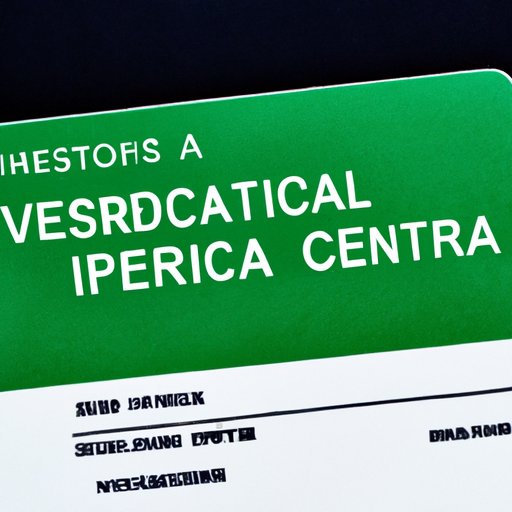Introduction
A green card, also known as a permanent resident card, is a document that allows foreign nationals to live and work permanently in the United States. It is a vital document for anyone seeking to build a life in the USA, and the process of obtaining one can be a challenging but rewarding experience.
However, the green card process can be lengthy and complicated, with many steps and requirements to fulfill. This article provides a comprehensive guide to understanding the green card process, including estimated timelines, potential obstacles, and tips for maximizing your chances of success.
Breaking Down the Green Card Process: A Timeline for Applicants
The green card application process consists of several steps, each of which requires its own set of documentation and processing time. The timeline for each step can vary, depending on factors such as the type of green card sought, the applicant’s country of origin, and the capacity of the agency responsible for processing the application.
The following is a brief overview of the green card application process timeline:
- File a petition (Form I-130 or I-140): From a few months to over a year.
- Get a priority date: This is the date of your place in line for a visa. Wait times can stretch years here.
- Wait your turn: You’ll have to wait your turn for your priority date to be current, which is based on category and country. Wait times are updated monthly at the Department of State website.
- File the adjustment of status (Form I-485) application (available if already in the US): From a few months to over a year.
- Get fingerprinted: Biometrics processing from a few weeks to over six months.
- Attend green card interview: Scheduling and wait times vary and can range from months to over a year.
- Receive a decision: From a few weeks to a few months.
It is important to note that these timelines are estimates only and depend on several factors. Applicants should be prepared for the possibility of longer-than-expected waits and should plan accordingly.
Navigating the Maze: Understanding the Timeline for Green Card Processing
As mentioned, the timeline for obtaining a green card can vary greatly from case to case. Part of the reason for this is the complex nature of the process, which involves multiple agencies and steps.
In general, the agencies involved in green card processing include:
- U.S. Citizenship and Immigration Services (USCIS)
- Department of State (DOS)
- Customs and Border Protection (CBP)
- Department of Labor (DOL)
To navigate this complicated process, it is essential to be prepared and organized. Keep all documents and paperwork in order, stay up to date on wait times and processing times, and seek help from knowledgeable sources when needed.
Green Card Timing: Factors That Affect Your Wait Time
Several factors can impact how long it takes to obtain a green card. These include:
- Category of green card application
- Country of origin
- Number of available visas in the applicant’s category
- Completeness and accuracy of application and supporting documents
- Level of demand for green cards in the applicant’s category
- Any errors or omissions in the application
To maximize your chances of success and speed up the process, it is essential to stay organized and on top of every detail of your application. Make sure all paperwork is accurate and complete, and be prepared to provide additional documentation if requested by USCIS.
The Journey to a Green Card: What to Expect from Each Step
Each step in the green card application process brings its own challenges and requirements. Here is a more detailed breakdown of each step:
- Filing a petition (Form I-130 or I-140): This involves submitting a formal application to USCIS establishing eligibility for a green card. Applicants will need to demonstrate their relationship to a US citizen or lawful permanent resident (for family-based applications) or their qualifications for the job (for employment-based applications).
- Getting a priority date: This happens after USCIS approves a petition, and applicants are given a place in line based on their priority date. Wait times to move up in line can take years, and statuses can be checked with the Department of State.
- Wait for turn: After getting a priority date, applicants must wait their turn in line for a visa. This typically involves waiting for their priority date to become current, which can be checked regularly on the Department of State’s website.
- File the adjustment of status (Form I-485) application: This step is only available to applicants who are already in the US, and it involves submitting an application to adjust their status to that of a permanent resident. Applicants will need to complete biometric processing, including a background check and fingerprinting.
- Get fingerprinted: During biometric processing, applicants will be required to provide fingerprints, which will be used to cross-reference immigration records and verify their identity. Biometric processing typically takes several weeks to a few months.
- Attend green card interview: Applicants will be required to attend an interview with a USCIS officer, where they will be asked to provide additional documentation and answer questions about their background and qualifications.
- Receive a decision: After the interview, USCIS will render a decision on the green card application. If approved, applicants will receive a green card in the mail.
Throughout each step of the process, applicants should be diligent, timely in their responses, and prepared for potential challenges that may arise.
The Waiting Game: Tips for Staying Patient Throughout the Green Card Process
Waiting for a green card can be a stressful and uncertain process, and it is essential to stay patient and positive throughout the journey. Here are some strategies for coping with the waiting game:
- Stay informed: Keep up to date with wait times, processing times, and any changes to the green card application process.
- Stay busy: Stay active and engaged with activities outside the green card process to keep your mind occupied and your spirits up.
- Stay positive: Focus on the end goal of obtaining a green card and the many opportunities that await once it is obtained.
By staying proactive and positive, applicants can increase their chances of success and make the waiting process more manageable.
Green Card Delays: Common Issues and How to Address Them
Despite careful planning and organization, green card applications can sometimes be delayed due to unforeseen circumstances. Common issues that can cause delays include:
- Missing or incomplete documentation
- Incomplete application forms or inconsistent information
- Background checks and investigations
- Problems with the U.S. Postal Service or other delivery services
- Problems with the immigration system or USCIS processing errors
To address these and other potential issues, applicants should seek guidance and support from knowledgeable sources and be prepared to follow up with USCIS regularly.

Getting to the Finish Line: Steps You Can Take to Speed Up Your Green Card Application
If you are eager to obtain a green card as quickly as possible, there are steps you can take to speed up the process. These include:
- Staying on top of your paperwork and ensuring all documentation is accurate and complete
- Responding promptly to requests for additional information or documentation from USCIS
- Applying under the category that offers the shortest wait times
- Working with a qualified and experienced immigration lawyer to help guide you through the process
By taking these steps, you can increase your chances of a faster and more successful green card application process.
Conclusion
Obtaining a green card can be a challenging and complex process, but with careful planning, organization, and persistence, it is possible to achieve permanent residency in the United States. By understanding the timeline for the green card process, potential challenges, and tips for success, applicants can maximize their chances of achieving their ultimate goal and building a better future for themselves and their families.
Remember to stay patient, positive, and proactive throughout the process, and seek guidance and support when needed. With dedication and hard work, the path to a green card can be a rewarding and fulfilling journey.
